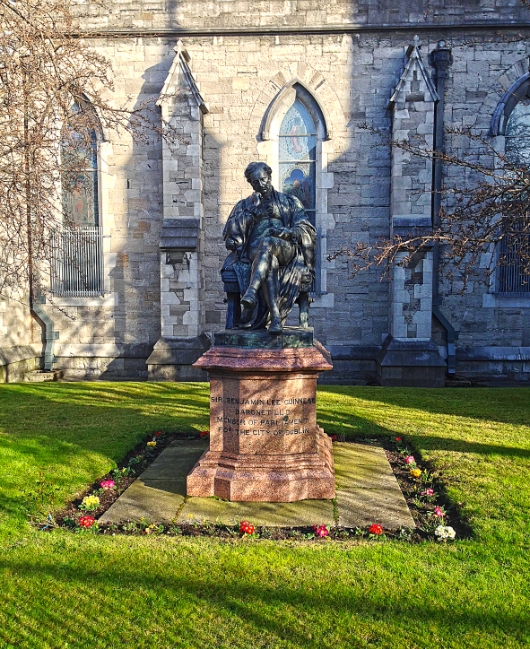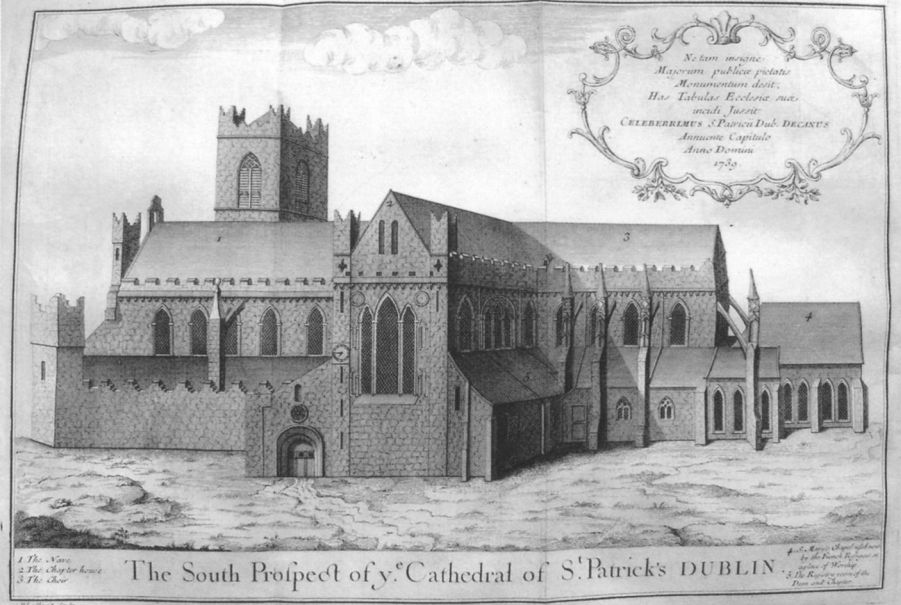Sitting in the winter sun on the south side of St Patrick’s Cathedral is a statue of Benjamin Lee Guinness. Named after his maternal grandfather, he was the third son of Arthur Guinness Jr and Anne Lee, after William, a clergyman, and Arthur Lee. After the latter’s death in 1839, Benjamin Lee assumed control of the family business from his father in 1840. He transformed the brewery from the largest in the city to the largest brewery of porter in the world.
As his fortune amassed, Benjamin Lee moved the family home from Number One, Thomas St (now marked with a plaque) to Stephen’s Green. Here he combined two houses in what Dickson calls a “kind of opulent Victorian palace not otherwise seen in in the city”. The transfer can be observed in street directories: in 1832, No. 1 was home of Arthur Guinness, Esq., in 1862 it was listed as a Brewer’s house, as the original brewery stood behind it. The family had lived in No. 1 since its construction in the 1750s-1760s. Casey describes the now seven bay building as much extended.
While philanthropy to varying degrees was common among the gentlemen of the early nineteenth century, Benjamin Lee brought this to new levels, spending £110,000 on the restoration of St. Patrick’s Cathedral, with the aim of restoring it to its “medieval magnificence”. The aim was to create a national cathedral. The building, like its neighbour at Christchurch had fallen into disrepair, and according to Cullen, demolition was considered in 1805. As the century progressed, some work was completed, but as disestablishment of the Church of Ireland was imminent, any significant state investment was unlikely. One could consider that the cathedral would not have survived but for his investment. The work was not without controversy—no architect was hired, and Guinness himself directed the project. A view of the Cathedral from 1739 demonstrates how much work was done subsequently.
He also began the restoration of Archbishop Marsh’s library. For this work and more, Benjamin Lee Guinness was created 1st Baronet Guinness of Ashford Castle in 1867. It was evidently a popular decision. A book of memorials from the citizens of Dublin ran to two volumes. As mentioned previously in the article on St Sepulchre’s Palace, the street in front of Benjamin Lee’s statue was for some time called Guinness St, before reverting to St Patrick’s Close. What a pity the name changed back!
Benjamin Lee Guinness died in 1868, a few months before his 70th birthday. His worth was put at £1.1 M at the time. An astute businessman, his will declared that the company could not be split, a decision which perhaps prevented his two sons with remaining interest from doing so. The Guinness empire continued to grow. His son Arthur, 2nd Baronet Guinness, and was later created 1st Baron Ardilaun, completed the work on Marsh’s Library, opened Stephen’s Green to the public (commemorated by a statue of Lord Ardilaun in the Green, facing the Royal College of Surgeons), and rebuilt the Coombe Hospital in 1880. He also initiated interest in the Dublin Artisan’s Dwelling Company (see article on Reginald St), that his brother would later take up in the form of the Iveagh Trust.
In 1876, Arthur sold his share to his brother Edward Cecil, a man who did much to transform the city of Dublin. He was created 1st Baron Iveagh in 1891, and the Viscountcy and the Earldom soon followed. There is plenty more to write about him of course, but for now we can say that a good claim to fame is that the two “cunning brothers” appear in Ulysses:
“a crystal cup full of the foamy ebon ale which the noble twin brothers Bungiveagh and Bungardilaun brew ever in their divine alevats, cunning as the sons of deathless Leda. For they garner the succulent berries of the hop and mass and sift and bruise and brew them and they mix therewith sour juices and bring the must to the sacred fire and cease not night or day from their toil, those cunning brothers, lords of the vat.”

No. 1 Thomas St, to the left of the entrance of St James Gate Brewery (Photo: July 2012 by informatique on Flickr)
You can receive email updates when a new post is published by subscribing below.
Notes
The amount spent on St Patrick’s Cathedral varies with the source. Dickson quotes £110,000.
- Christine Casey (2005) The Buildings of Dublin, Yale University Press.
- Frank Cullen (2015) Dublin 1847: City of the Ordnance Survey, RIA (Dublin).
- David Dickson (2014) Dublin – The Making of a Capital City, Lilliput (Dublin).
- Roger Stalley (2009) St Patrick’s Cathedral Dublin, Irish Arts Review 26(3), 116-119.




If you don’t mind my saying so, I think you’re mixing up your barons and your baronets. A baronet is not a peer or a nobleman. Sir Benjamin Lee Guinness was a baronet and his baronetcy could be inherited, but he was not a nobleman (though he may have been a noble man). Arthur inherited the baronetcy but later became Baron Ardilaun. Edward Cecil was made a baronet but later became Baron Iveagh, Viscount Iveagh and Earl of Iveagh. See Wikipedia articles on all of them and on baronetcy.
I’ll get my coat ….
bjg
Thanks for that! I was reading various sources and confess that I assumed they were the same thing. Note to self: always check! Please don’t get you coat, I really appreciate you explaining the difference. The article title changed from Baronet to Baronets as I wrote – I thought I was being smart…
Michael
Thank you for your open-minded response. Please feel free to do the same on my site! bjg
Hi Brian,
I’ve finally got around to making minor amends so hopefully it now takes your comment into account! By the way, your site is amazing!
Thanks again,
Michael
“Arthur Lee … After the latter’s death in 1839 …” – ah, no. Arthur Lee Guinness left the partnership around 1839/40, under somewhat mysterious circumstances, and went off to live in some luxury in Stillorgan. He finally died in 1865.